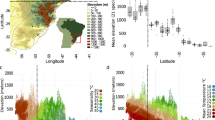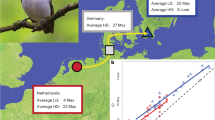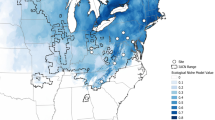Abstract
Evolutionary theory predicts that local population divergence will depend on the balance between the diversifying effect of selection and the homogenizing effect of gene flow1,2,3. However, spatial variation in the expression of genetic variation will also generate differential evolutionary responses. Furthermore, if dispersal is non-random it may actually reinforce, rather than counteract, evolutionary differentiation. Here we document the evolution of differences in body mass within a population of great tits, Parus major, inhabiting a single continuous woodland, over a 36-year period. We show that genetic variance for nestling body mass is spatially variable, that this generates different potential responses to selection, and that this diversifying effect is reinforced by non-random dispersal. Matching the patterns of variation, selection and evolution with population ecological data, we argue that the small-scale differentiation is driven by density-related differences in habitat quality affecting settlement decisions. Our data show that when gene flow is not homogeneous, evolutionary differentiation can be rapid and can occur over surprisingly small spatial scales. Our findings have important implications for questions of the scale of adaptation and speciation, and challenge the usual treatment of dispersal as a force opposing evolutionary differentiation.
This is a preview of subscription content, access via your institution
Access options
Subscribe to this journal
Receive 51 print issues and online access
$199.00 per year
only $3.90 per issue
Buy this article
- Purchase on Springer Link
- Instant access to full article PDF
Prices may be subject to local taxes which are calculated during checkout





Similar content being viewed by others
References
Endler, J. A. Natural Selection in the Wild (Princeton Univ. Press, Princeton, New Jersey, 1986)
Endler, J. A. Geographic Variation, Speciation, and Clines (Princeton Univ. Press, Princeton, New Jersey, 1977)
Slatkin, M. Gene flow and the geographic structure of natural populations. Science 236, 787–792 (1987)
Felsenstein, J. The theoretical population genetics of variable selection and migration. Annu. Rev. Genet. 10, 253–280 (1976)
García-Ramos, G. & Kirkpatrick, M. Genetic models of adaptation and gene flow in peripheral populations. Evolution 51, 21–28 (1997)
Smith, T. B., Wayne, R. K., Girman, D. J. & Bruford, M. W. A role for ecotones in generating rainforest biodiversity. Science 276, 1855–1857 (1997)
Hendry, A. P., Day, T. & Taylor, E. B. Population mixing and the adaptive divergence of quantitative traits in discrete populations: a theoretical framework for empirical tests. Evolution 55, 459–466 (2001)
Doebeli, M. & Dieckmann, U. Speciation along environmental gradients. Nature 421, 259–264 (2003)
Barton, N. H. in Dispersal (eds Clobert, J., Danchin, E., Dhondt, A. A. & Nichols, J. D.) 329–340 (Oxford Univ. Press, 2001)
Verhulst, S., Perrins, C. M. & Riddington, R. Natal dispersal of great tits in a patchy environment. Ecology 78, 864–872 (1997)
Braillet, C. et al. Two blue tit Parus caeruleus populations from Corsica differ in social dominance. J. Avian Biol. 33, 446–450 (2002)
Naeff-Daenzer, B., Widmer, F. & Nuber, M. Differential post-fledging survival of great and coal tits in relation to their condition and fledging date. J. Anim. Ecol. 70, 730–738 (2001)
Garant, D., Kruuk, L. E. B., McCleery, R. H. & Sheldon, B. C. Evolution in a changing environment: a case study with great tit fledging mass. Am. Nat. 164, E115–E129 (2004)
Merilä, J., Kruuk, L. E. B. & Sheldon, B. C. Cryptic evolution in a wild bird population. Nature 412, 76–79 (2001)
Jensen, H. et al. Sexual variation in heritability and genetic correlations of morphological traits in house sparrow (Passer domesticus). J. Evol. Biol. 16, 1296–1307 (2003)
Harvey, P. H., Greenwood, P. J. & Perrins, C. M. Breeding area fidelity of Great tits (Parus major). J. Anim. Ecol. 48, 305–313 (1979)
Minot, E. O. & Perrins, C. M. Interspecific interference competition—nest sites for blue and great tits. J. Anim. Ecol. 55, 331–350 (1986)
Lynch, M. & Walsh, B. Genetics and Analysis of Quantitative Traits (Sinauer, Sunderland, Massachusetts, 1998)
Hoffman, A. A. & Merilä, J. Heritable variation and evolution under favourable and unfavourable conditions. Trends Ecol. Evol. 14, 96–101 (1999)
van der Jeugd, H. P. & McCleery, R. Effects of spatial autocorrelation, natal philopatry and phenotypic plasticity on the heritability of laying date. J. Evol. Biol. 15, 380–387 (2002)
Spitze, K. Population structure in Daphnia obtusa: Quantitative genetic and allozymic variation. Genetics 135, 367–374 (1993)
Blondel, J., Dias, P. C., Perret, P., Maistre, M. & Lambrechts, M. M. Selection-based biodiversity at a small spatial scale in a low-dispersing insular bird. Science 285, 1399–1402 (1999)
Postma, E. & van Noordwijk, A. J. Gene flow maintains a large genetic difference in clutch size at a small spatial scale. Nature doi:10.1038/nature03083 (this issue)
Perrins, C. M. Population fluctuations and clutch size in the great tit, Parus major L. J. Anim. Ecol. 34, 601–647 (1965)
Neumaier, A. & Groeneveld, E. Restricted maximum likelihood estimation of covariances in sparse linear models. Genet. Sel. Evol. 30, 3–26 (1998)
Groeneveld, E., Kovac, M., Wang, T. L. & Fernando, R. L. Computing algorithms in a general purpose BLUP package for multivariate prediction and estimation. Arch. Anim. Breed. 35, 399–412 (1992)
Fairbairn, D. J. & Preziosi, R. F. Sexual selection and the evolution of sexual size dimorphism in the water strider, Aquarius remigis . Evolution 50, 1549–1559 (1996)
VSN International, Genstat version 7.1 (VSN International, Oxford, 2003)
Rhynsburger, D. Analytic delineation of Theissen polygons. Geogr. Anal. 5, 133–144 (1973)
Minot, E. O. Effects of interspecific competition for food in breeding blue and great tits. J. Anim. Ecol. 50, 375–385 (1981)
Acknowledgements
We are grateful to A. Charmantier, A. G. Gosler, J. L. Quinn and C. M. Perrins for comments on the manuscript and to the many people who collected data during the long-term tit study in Wytham. D.G. was financially supported by a Natural Sciences and Engineering Research Council of Canada (NSERC) Postdoctoral Research Fellowship, and by a Biotechnology and Biological Sciences Research Council (BBSRC) grant to B.C.S. and L.E.B.K, who are both Royal Society University Research Fellows; T.A.W. was funded by a studentship from the BBSRC.Authors' contributions D.G. conducted analyses and discovered the original pattern, and drafted the manuscript together with B.C.S., who also provided overall guidance, and L.E.B.K., who also advised over quantitative genetic analyses. T.A.W. conducted spatial analyses. R.H.McC. maintained the long-term database.
Author information
Authors and Affiliations
Corresponding author
Ethics declarations
Competing interests
The authors declare that they have no competing financial interests.
Supplementary information
Supplementary Information Figure 1
Illustrates the detailed patterns of dispersal in Wytham woodland and shows the average annual contribution of residents and immigrants to each of the breeding area of the wood. (DOC 146 kb)
Supplementary Information Methods
This file contains further details on the difference between the statistical analyses performed using a cross-sectional (yearly average of individuals) approach versus a linear mixed modelling method (information for each individual included). (DOC 19 kb)
Rights and permissions
About this article
Cite this article
Garant, D., Kruuk, L., Wilkin, T. et al. Evolution driven by differential dispersal within a wild bird population. Nature 433, 60–65 (2005). https://doi.org/10.1038/nature03051
Received:
Accepted:
Issue Date:
DOI: https://doi.org/10.1038/nature03051
This article is cited by
-
Differential effects of steroid hormones on levels of broad-sense heritability in a wild bird: possible mechanism of environment × genetic variance interaction?
Heredity (2022)
-
Simplified Phasmatodea population evolution algorithm for optimization
Complex & Intelligent Systems (2022)
-
The Importance of Intraspecific Variation for Niche Differentiation and Species Distribution Models: The Ecologically Diverse Frog Pleurodema thaul as Study Case
Evolutionary Biology (2020)
-
Children with Behavioural Problems Misinterpret the Emotions and Intentions of Others
Journal of Abnormal Child Psychology (2020)
-
The role of habitat configuration in shaping social structure: a gap in studies of animal social complexity
Behavioral Ecology and Sociobiology (2019)
Comments
By submitting a comment you agree to abide by our Terms and Community Guidelines. If you find something abusive or that does not comply with our terms or guidelines please flag it as inappropriate.



